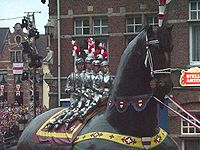
Ardennes is a department in the Grand Est region of northeastern France named after the broader Ardennes. Its prefecture is the town Charleville-Mézières. The department has 270,582 inhabitants. The inhabitants of the department are known as Ardennais or Ardennaises.
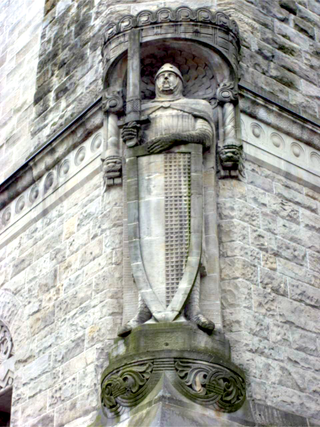
Roland was a Frankish military leader under Charlemagne who became one of the principal figures in the literary cycle known as the Matter of France. The historical Roland was military governor of the Breton March, responsible for defending Francia's frontier against the Bretons. His only historical attestation is in Einhard's Vita Karoli Magni, which notes he was part of the Frankish rearguard killed in retribution by the Basques in Iberia at the Battle of Roncevaux Pass.
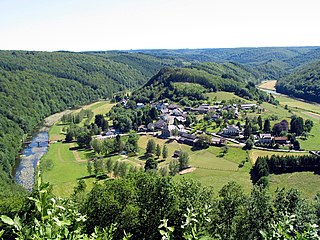
The Ardennes, also known as the Ardennes Forest or Forest of Ardennes, is a region of extensive forests, rough terrain, rolling hills and ridges primarily in Belgium and Luxembourg, extending into Germany and France.

Dinant is a city and municipality of Wallonia located in the province of Namur, Belgium. On the shores of river Meuse, in the Ardennes, it lies 90 kilometres (56 mi) south-east of Brussels, 30 kilometres (19 mi) south-east of Charleroi and 30 kilometres (19 mi) south of the city of Namur. Dinant is situated 20 kilometres (12 mi) north of the border with France.

The chanson de geste is a medieval narrative, a type of epic poem that appears at the dawn of French literature. The earliest known poems of this genre date from the late 11th and early 12th centuries, shortly before the emergence of the lyric poetry of the troubadours and trouvères, and the earliest verse romances. They reached their highest point of acceptance in the period 1150–1250.
Doon de Mayence also known as Doolin de Maience, Doon de Maience or Doolin de Mayence was a fictional hero of the Old French chansons de geste, who gives his name to the third cycle of the Charlemagne romances dealing with the feudal revolts.
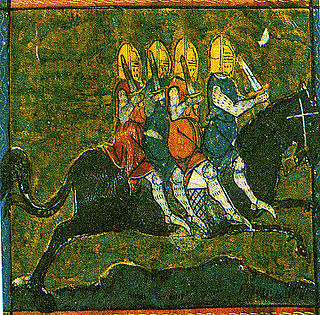
Bayard is a magic bay horse in the legends derived from the medieval chansons de geste. These texts, especially that of The Four Sons of Aymon, attribute to him magical qualities and a supernatural origin. He is known for his strength and intelligence, and possesses the supernatural ability to adjust his size to his riders.

Renaudde Montauban was a legendary hero and knight which appeared in a 12th-century Old French chanson de geste known as The Four Sons of Aymon. The four sons of Duke Aymon are Renaud, Richard, Alard and Guiscard, and their cousin is the magician Maugris. Renaud possesses the magical horse Bayard and the sword Froberge.

In the Matter of France, Ganelon is the knight who betrayed Charlemagne's army to the Saracens, leading to the Battle of Roncevaux Pass. His name is said to derive from the Italian word inganno, meaning fraud or deception. He is based upon the historical Wenilo, the archbishop of Sens who betrayed King Charles the Bald in 858.

Maugris or Maugis was one of the heroes of the chansons de geste and romances of chivalry and the Matter of France that tell of the legendary court of King Charlemagne. Maugis was cousin to Renaud de Montauban and his brothers, son of Beuves of Aygremont and brother to Vivien de Monbranc. He was brought up by Oriande the fairy, and became a great enchanter. He won the magical horse Bayard and the sword Froberge which he later gave to Renaud.
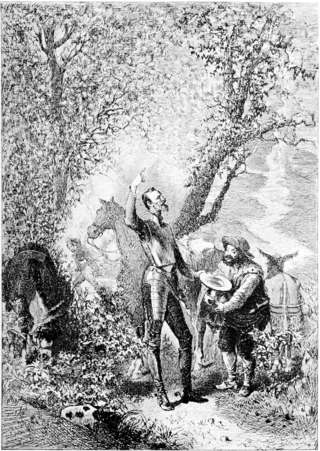
Mambrino was a fictional Moorish king, celebrated in the romances of chivalry. His first appearance is in the late fourteenth-century Cantari di Rinaldo, also known as Rinaldo da Monte Albano, Rinaldo Innamorato or Innamoramento di Rinaldo. The Cantari di Rinaldo is an adaptation of the Old French chanson de geste, Renaud de Montauban, also known as Les Quatre Fils Aymon. In the Old French, Renaud defeats the Saracen king Begon, who was invading King Yon’s kingdom of Gascony. The Italian replaces Begon with Mambrino, and furnishes him with an elaborate backstory. In the Cantari, Mambrino is one of six brothers, all giants. Four of the brothers had been decapitated by Rinaldo on various occasions earlier in the poem, so that his invasion of Gascony was motivated by his desire for vengeance. Rinaldo, as the Italians called Renaud, wins the war by defeating Mambrino in single combat and decapitating him as well. Mambrino’s helmet, in this poem, has for its crest an idol which is so constructed that whenever the wind blows through it, it says, “Long live the most noble lord Mambrino, and all his barons.”
Duke Aymon of Dordone is a character in the Old French Matter of France, appearing in chansons de geste and Italian romance epics depicting the adventures of Charlemagne and his knights. The son of Doon de Mayence, he is the Duke of Dordone and the father of four sons, Renaud, Guichard, Alard and Richard, who are the heroes of Les Quatre Fils Aymon or The Four Sons of Aymon.
French folklore encompasses the fables, folklore, fairy tales and legends of the French people.
"Doon" is an anonymous Breton lai that tells the story of a knight, Doon, who must pass certain tests to win the hand of a maiden. They marry; but he returns to France alone. He is later reunited with the lady thanks to their grown son, whom he recognizes after dueling him at a tournament. This lai is very similar to "Milun" by Marie de France.

Bogny-sur-Meuse is a commune in the Ardennes department in the Grand Est region of northern France. Bogny-sur-Meuse is known for multiple sites linked to the medieval legend of The Four Sons of Aymon, such as the Hermitage, the statue of Bayard the horse, and the four peaks symbolizing the four brothers. Situated in the Ardennes mountains, the commune extends along the banks of the Meuse.
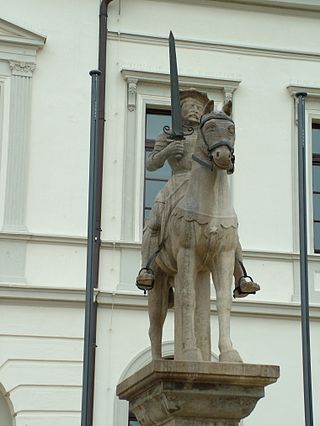
Veillantif (French), Vielantiu ; Vegliantin, Vegliantino or Brigliadoro (Italian) is the name of Roland the paladin's trustworthy and swift steed in the stories derived from the chansons de geste. The French name comes from an expression meaning "vigilant". Veillantif is first mentioned in The Song of Roland.

Reinold was a Benedictine monk who lived in the 10th century. Supposedly a direct descendant of Charlemagne, and the fourth son mentioned in the romantic poem Duke Aymon, by William Caxton. The poem is Caxton's translation of the long French Chanson de Geste, Les Quatre Fils Aymon, where Renaud de Montauban dies in an almost identical manner. He began his religious life by entering the Benedictine monastery of Pantaleon in Cologne, Germany, where he was appointed head of a building project occurring in the abbey. He often joined the stonemasons in their work, at times surpassing them. This led to the unsavoury event of his murder at the hands of the same stonemasons he worked with. Reinold was beaten to death with hammers and his body deposited into a pool near the Rhine. His body was later found through divine means, leading to the attribution of Reinold as the Patron of Stonemasons.
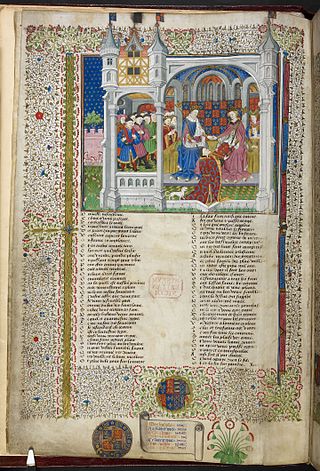
The Talbot Shrewsbury Book is a very large richly-illuminated manuscript made in Rouen (Normandy) in 1444/5. It was presented by John Talbot, 1st Earl of Shrewsbury to the French princess, Margaret of Anjou, in honour of her betrothal to King Henry VI. It contains a unique collection of fifteen texts in French, including chansons de geste, chivalric romances, treatises on warfare and chivalry, and finally the Statutes of the Order of the Garter. The work is an excellent example of book production in Rouen in the mid-fifteenth century and provides a rare insight into the political views of the English military leader and close confidant of the crown, John Talbot.
Cortain or Corte is a legendary short sword in the legend of Ogier the Dane. This name is the accusative case declension of Old French corte, meaning "short".

The château des fées, château défait or château du Waridon is a medieval fortress whose ruins lie on the upper Meuse near Le Waridon in the commune of Montcy-Notre-Dame) of the Ardennes. Its origins date back to between the 9th and 16th centuries.











